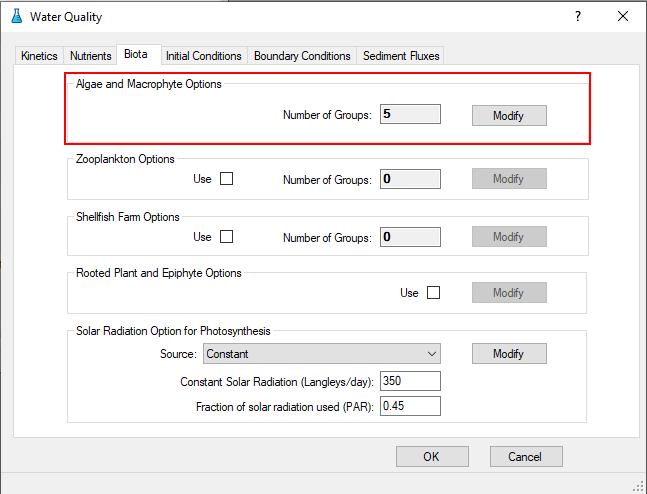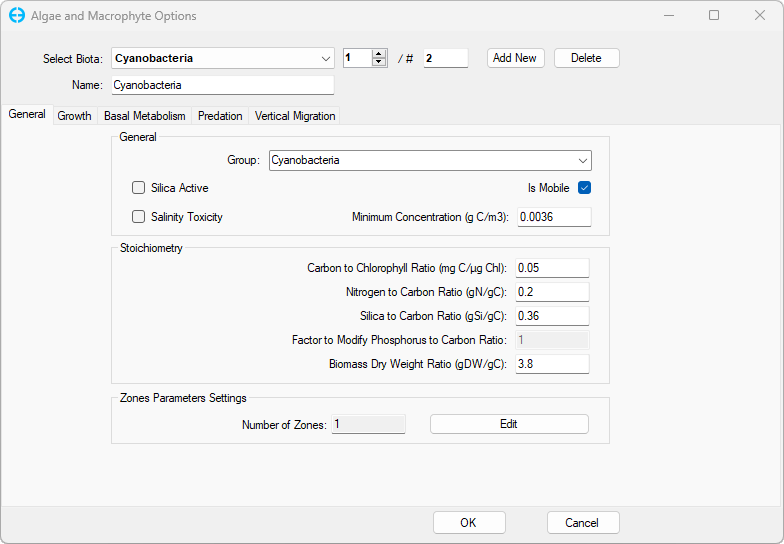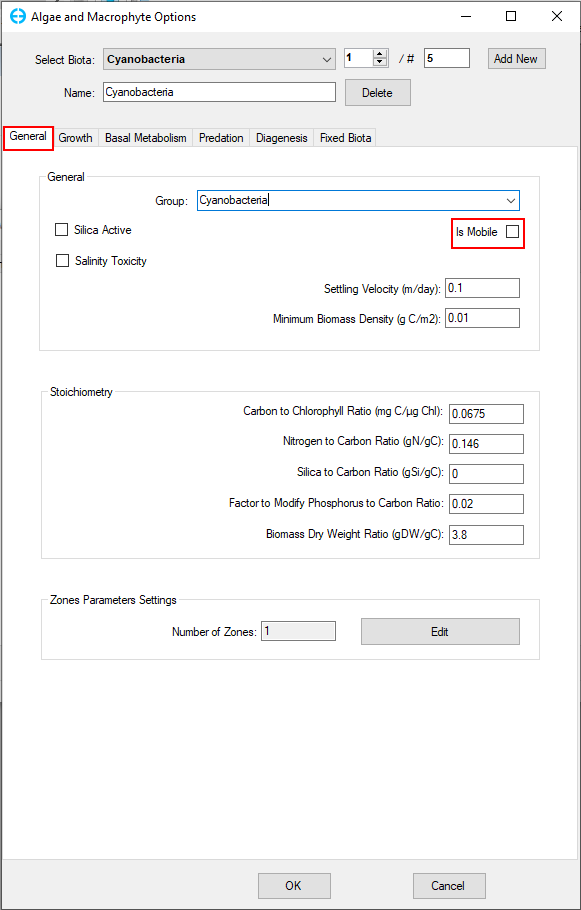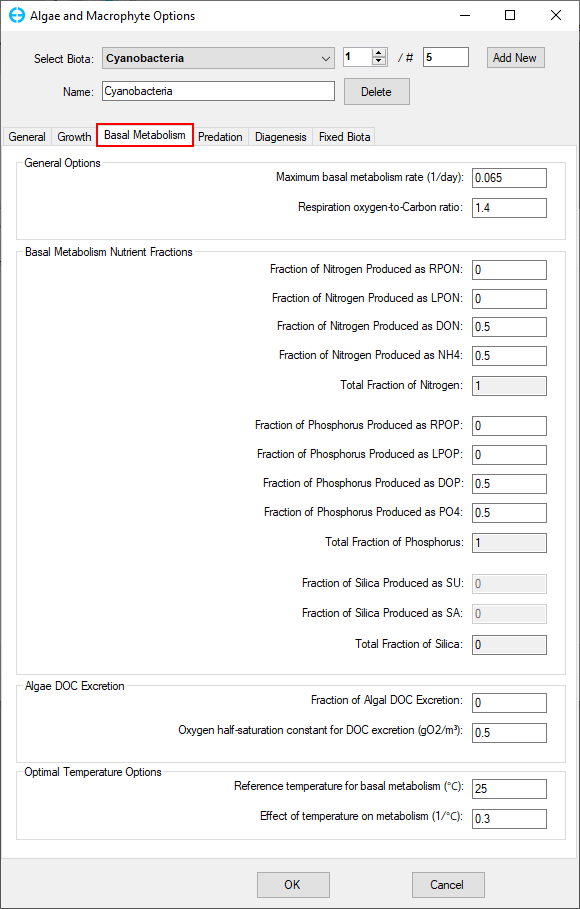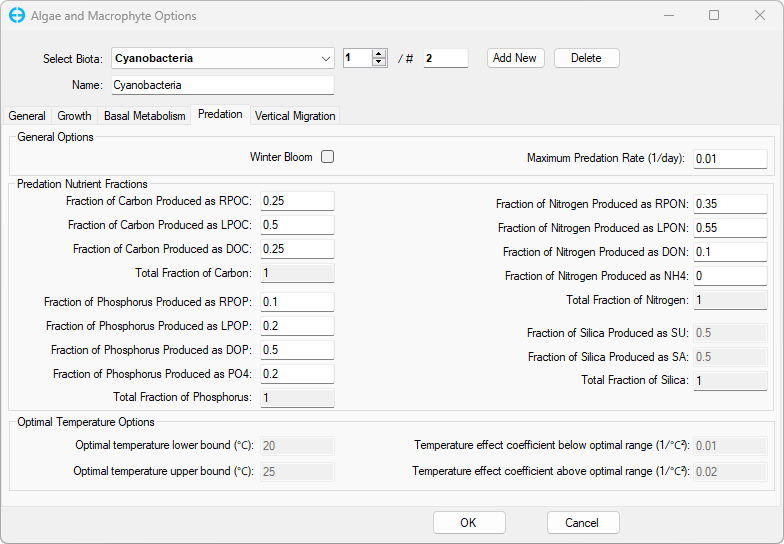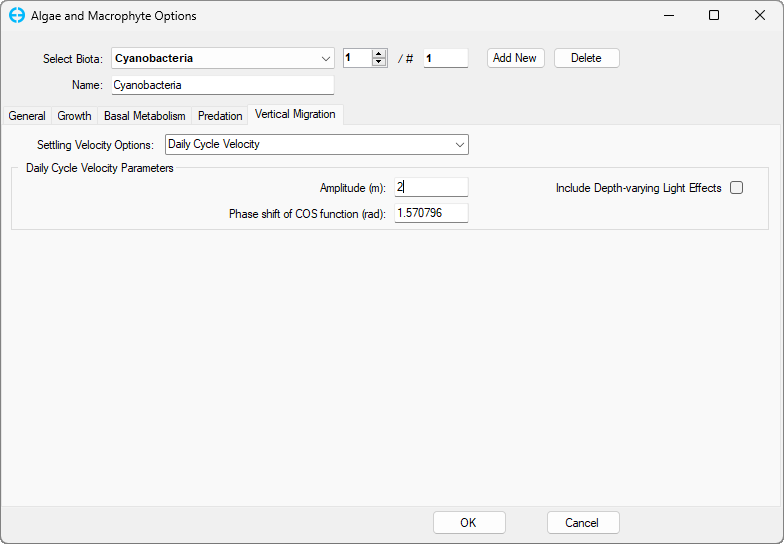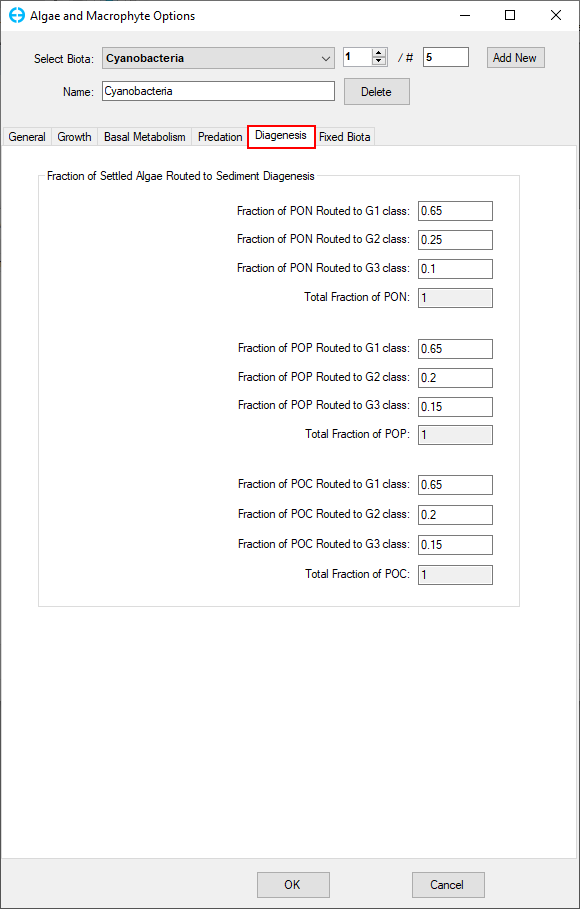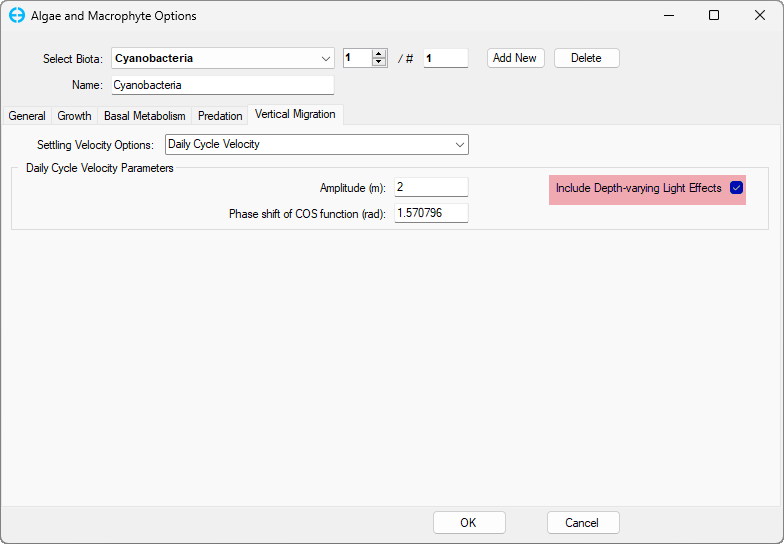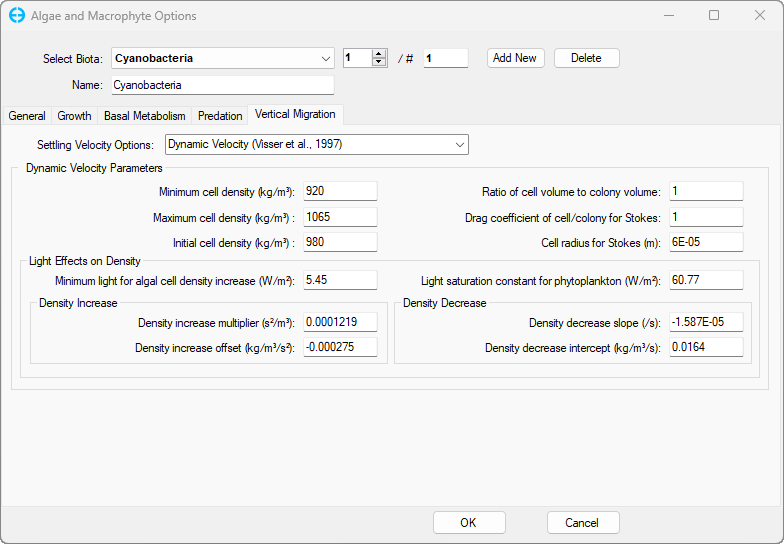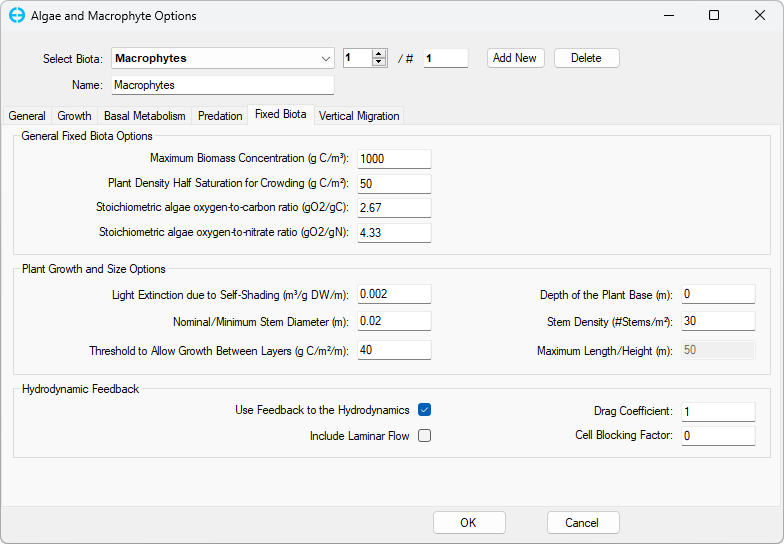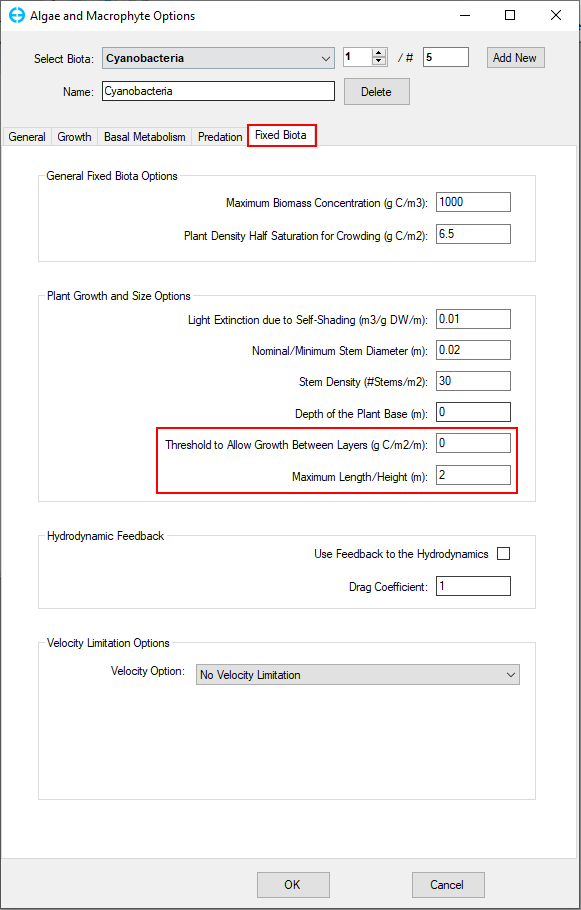EEMS allows users to simulate an unlimited number of algal and macrophyte groups, with each group assigned different parameters such as half-saturation constants and uptake rates for nutrients according to the aquatic ecosystem model. To open In the Macrophyte and Algae Options frame, RMC on the Biota under Water Quality Model Control (Figure 1). In the Macrophyte and Algae Options frame, the algae and users should input the number of algal groups to be simulated as Figure 1. Click the Modify button to being editing parameters for each group. The macrophyte parameters are classified flowing its kinetics processes in each sub-tab.
| Anchor | ||||
|---|---|---|---|---|
|
Figure 1. Water Quality Model Control Macrophyte and Algae Options.
1. General
In the General tab (Figure 2), users can define the number of algae and macrophyte group simulating in the model. Users can also input the name and different general parameters for each group.If an algal group is defined as a macrophyte, for the algal group and other parameters.
With the new macrophytes options in EFDC+, biota can be mobile or fixed. If the Is Mobile box needs to be is unchecked. The Fixed Biota subtab will be displayed and allow users to modify additional parameters and options for modeling of the macrophyte.can be enabled.
Anchor Figure 2 Figure 2
Figure 2. Macrophyte and Algae Options: General.
...
The process of algae growth is described in the Growth sub-tab ( as shown in 1033371734Figure 3) with growth parameters and optimal temperature options.
Anchor Figure 3 Figure 3
Figure 3. Macrophyte and Algae Options: Growth.
3. Basal Metabolism
1033371734 Figure 4 shows the Basal Metabolism sub-tab includes General Options, Basal Metabolism Nutrient Fractions, Algae DOC Excretion, and Optimal Temperature Options.
Anchor Figure 4 Figure 4
Figure 4. Macrophyte and Algae Options: Basal Metabolism.
4. Predation
1033371734 Figure 5 shows the Predation sub-tab. If the box of Winter Bloom in General Options is checked, the Optimal Temperature Options will enable.
Anchor Figure 5 Figure 5
Figure 5. Macrophyte and Algae Options: Predation.
5.
...
The EEMS 12 offers a modeling feature to simulate the vertical migration of algae, which will be beneficial for algae bloom management and mitigation. Four options are available to determine the settling velocity of cyanobacteria and any other algal species.
Figure 6a shows the Vertical Migration subtab with the Constant Velocity approach which is set as the default option in EE.
...
Figure 6a. Macrophyte and Algae Options: Vertical Migration - Constant Velocity (default option).
Figure 6b shows the setup for the Daily Cycle Velocity model option. In this model, only Amplitude and Phase shift of COS function are needed as input parameters.
...
...
Diagenesis
When using Full Diagenesis Model option in Sediment Fluxes, the tab of Diagenesis is available as in Figure 6.
Anchor Figure 6 Figure 6
Figure 6. Macrophyte and Algae Options: Vertical Migration - Daily Cycle Velocity.
Users also can select the Daily Cycle Velocity with Depth-varying Light Effects option by checking the box Include Dept-varying Light Effects as shown in Figure 6c.
...
Figure 6c. Macrophyte and Algae Options: Vertical Migration - Daily Cycle Velocity with Depth-varying Light Effects.
Figure 6d shows the setup for of the Dynamic Velocity model, based on Visser et al., 1997, which is the most advanced option in EE for the modeling of algae vertical migration.
...
Figure 6d. Macrophyte and Algae Options: Vertical Migration - Daily Cycle Velocity with Depth-varying Light Effects.
6. Fixed Biota
...
Diagenesis.
6. Fixed Biota
The fixed biota parameter is presented in the Fixed Biota sub-tab ( as shown in 1033371734). A layered threshold value of biomass concentration is specified. The macrophyte growth upward is accomplished by moving the biomass of a layer to the layer above if the concentration in the layer is greater than a threshold concentration and the concentration in the upper layer is less than the same threshold concentration. Note Figure 7)
Note that: the Maximum Length/Height is only considered when the Threshold to Allow Growth between Layers is set to zero. The feedback of macrophyte growth and its density on the hydrodynamics is also optionally considered by checking the box Use Feedback to the Hydrodynamics in Hydrodynamic Feedback frame.When there is no threshold, the macrophyte can grow between layers and reach any height. Therefore, a maximum height is needed in this case to control the macrophyte height.
| Anchor | ||||
|---|---|---|---|---|
|
Figure 67. Macrophyte and Algae Options: Fixed Biota
...

